Uptrend seen due to improved demand
Mumbai
New tuar crop started to arrive in the mandis of Karnataka and Maharashtra. The moisture content in this new crop is 20/25 percent, which is quite high and is consequently affecting the quality. Demand from stockists and millers has improved and there was a sharp jump in prices last week.
Due to better demand, prices of imported stock also saw an uptrend and prices of Lemon rose to Rs. 6,050/6,075, Arusha to Rs. 5,400, Gajri to Rs. 5,400, Sudan to Rs. 6,300 and Malawi to Rs. 4,900 per quintal.
Burma
Due to better export demand, Burma tuar Lemon rose by $ 20 and Linke by $ 30 per ton and traded at $ 770 and $ 780 per ton respectively.
Delhi
Last week, Delhi tuar registered a rise of Rs. 125/150 per quintal, supported by the increase in prices in the imported and domestic markets. Old Lemon stock was sold at Rs. 6,150, new at Rs. 6,400, Maharashtra at Rs. 6,350, Haryana/Uttar Pradesh at Rs. 5,750 and Madhya Pradesh at Rs. 5,950 per quintal.
Maharashtra
Due to better demand from stockists and mills, Maharashtra registered good growth and last week, large volumes of new tuar crop arrived in the mandis of Maharashtra. Latur prices jumped up by Rs. 250, Akola by Rs. 250, Nagpur by Rs. 250, Amravati by Rs. 300 and Jalna by Rs. 200/300. With this increase, Latur traded at Rs. 6,350/6,450, Akola at Rs. 6,400, Nagpur at 6,500/6,550, Amravati at Rs. 6,000/6,200 and Jalna at Rs. 5,500/6,000 per quintal.
Karnataka
Karnataka prices registered a big increase this week due to improved demand from mills and continued consumption. This week, Gulbarga prices increased by Rs. 150/250, Bidar by Rs. 300 and Raichur by Rs. 200 per quintal. Gulbarga Pink prices increased to Rs. 6,100/6,400, Maruti to Rs. 6,300/6,500, Bidar to Rs. 6,000/6,171 and Raichur to Rs. 5,470/6,211.
Other
Katni prices registered an increase of Rs. 250 per quintal due to strong demand from mills and prices went up to Rs. 6,400/6,475. Similarly, an increase of Rs. 150 was registered in Kanpur this week, bringing prices to Rs. 6,150/6,200 per quintal. A sharp jump of Rs. 200 per quintal was also registered in Raipur and the prices of Lemon and Maharashtra/Karnataka line rose to Rs. 6,750 and Rs. 6,800/6,850, respectively.
Processed Tuar/Tuar Dal
Demand for tuar dal improved last week with an increase of Rs. 100/200 per quintal registered in Delhi, bringing prices to Rs. 8,925/9,250. In Katni, princes were Rs. 8,725/8,875, in Raipur Rs. 8,450/8,600, in Latur Rs. 8,800/9,000, in Gulbarga Rs. 8,700/9,100 and in Indore Rs 8,700/8,900.
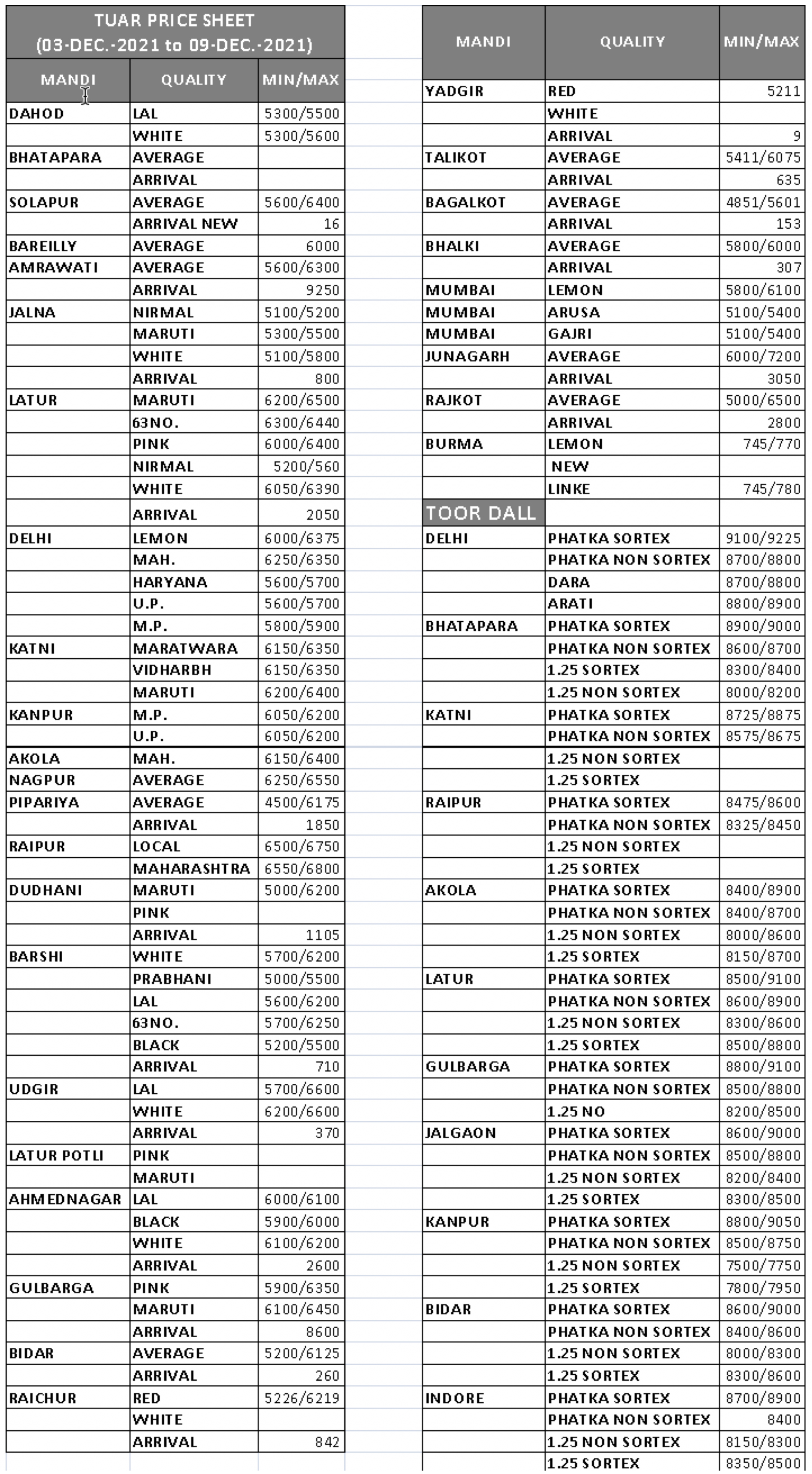
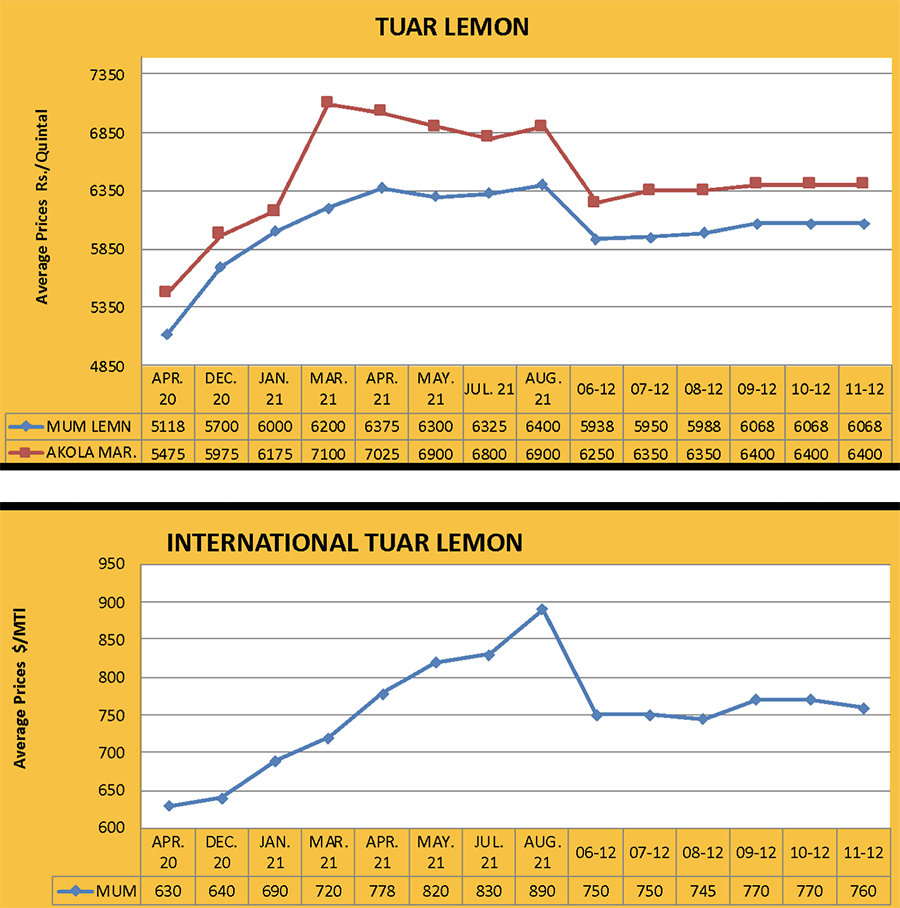
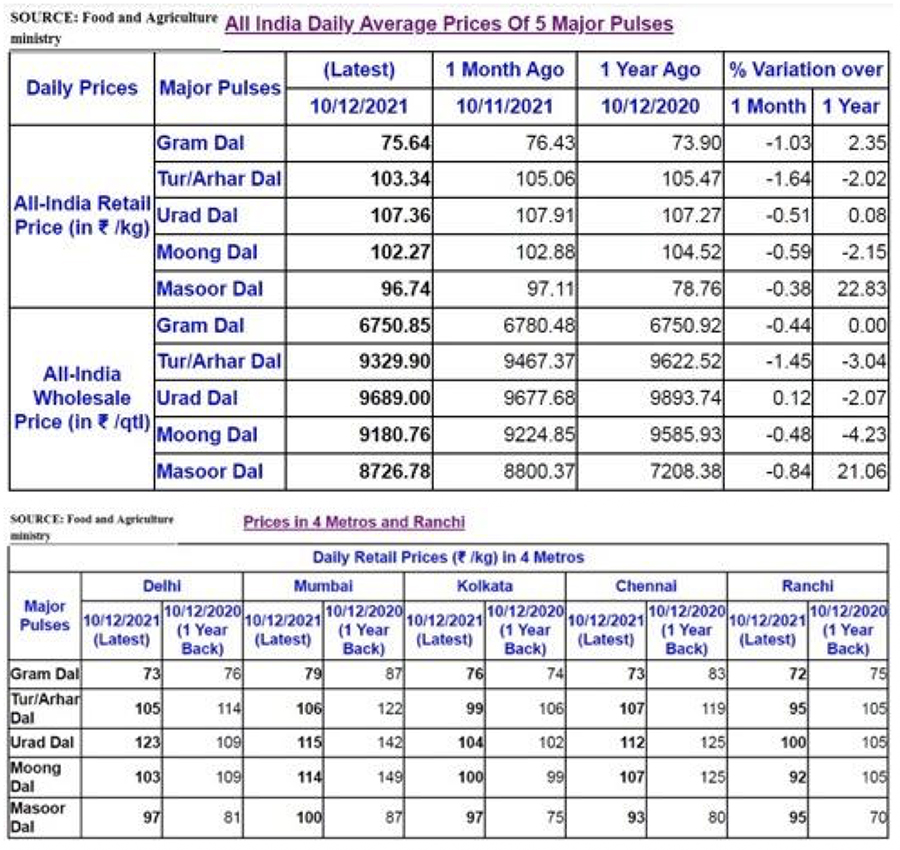
US Senator urges India to end controls on pulses
Washington. US Senator of Montana, Steve Daines, congressman for Montana, has urged the Indian government to end regulations on pulses, in particular the high import duties, citing harm to farmers in his state, which is a major pulse producer. The issue was raised by the US lawmaker during a meeting with the Union Minister of Commerce and Industry.
India is the largest buyer of pulses in the world and is an important potential market for Montana growers, but both countries should create an equal level of competition and necessary steps need to be taken to increase the reach of US pulses in India. Daines was referring to peas and lentils, which are subject to a high import duty in India. The import of peas in India is currently closed and volumes of US-imported lentils are negligible as they have a much higher customs duty as compared to Canada and Australia. The US Senator also gave a letter signed by several institutions of Montana to the Commerce Minister of India, urging him to remove the customs duty and other restrictions. During his visit to India, the US Senator also met some pulse importers from India at the Naya Bazar in Delhi. Daines follows on from former US President Donald Trump who, during his visit to India in February 2020, also gave a letter written by the senator to the Prime Minister.
Weather favorable for sowing and progress of Rabi pulses crops
New Delhi. Due to late rains and a fall in temperature of the south-west monsoon, there is sufficient soil moisture content in the fields of most parts of the country, helping the farmers in their cultivation of Rabi crops. The farming community is showing interest in sowing pulses. According to official data, until December 10, the total area of pulses crops was 129.74 lakh hectares, which is 46,000 hectares more than the 129.28 lakh hectares sown as of the same time last year.
The sowing process will continue in December and the total area is expected to increase further. In the Rabi season the main crops sown are gram, lentil, peas, kulthi, khesari, urad and moong. Cultivation of urad and moong is also done in the Kharif season. As was expected, the area of lentils has increased from 14.2 lakh hectares last year to 14.89 lakh hectares. Uttar Pradesh, Madhya Pradesh, Bihar and Bengal are the major producing states of lentils. The market price of lentils has already jumped to the highest levels and, despite heavy imports from abroad, prices are not set to come down much.
Although the area of gram increased from 90.68 lakh hectares to 92.89 lakh hectares, prices have been fluctuating for a while. Surprisingly, farmers are showing less interest in pea cultivation with the sown area falling from 9.06 lakh hectares last year to 8.6 lakh hectares this year, but the area is expected to increase soon. The production area of urad and moong is far behind both the levels of last year and the normal average. The area of kulthi is also behind, while khesari is ahead. The picture of the total sown area of pulses will become clearer after mid-December.
Sowing of Rabi crops completed in 94.65 percent of the target in Rajasthan
Jaipur. In Rajasthan, an important agricultural producing state located in the western part of the country, the total area of Rabi crops had increased to 95.41 lakh hectares by December 10, 2021, much higher than the sown area of 87.11 lakh hectares in the same period last year. The total sown area is currently at 94.65 percent of the fixed target of 100.80 lakh hectares.
The average area of Rabi crops in Rajasthan is estimated at 96.92 lakh hectares compared to last year's 98.80 lakh hectares.
According to the latest weekly report of the State Agriculture Department, the area of wheat production in Rajasthan has decreased from 25.28 lakh hectares to 24.92 lakh hectares and barley has improved from 2.81 lakh hectares to 2.91 lakh hectares as compared to last year. Consequently, the total area of cereal crops has reduced from 28.10 lakh hectares last year to 27.83 lakh hectare this year.
The area of pulses has decreased from 20.197 lakh hectares to 19.40 lakh hectares with the production area of gram decreasing from 19.92 lakh hectares to 19.43 lakh hectares. Other pulses, however, have improved, from 26,700 to 27,680 hectares. In this way, the gross production area of food crops including wheat, barley and pulses, has reduced from 48.29 lakh hectares last year to 45.54 lakh hectares.
There was a large increase in the sowing of oilseed crops, especially mustard. As compared to last year, the area of mustard in Rajasthan has jumped from 24.03 lakh hectares to 33.42 lakh hectares, the area of tTaramira has increased from 58,800 hectares to 1.36 lakh hectares and linseed has improved from 6.10 thousand hectares to 6.7 thousand hectares. The total sown area of oilseeds has jumped from 24.68 lakh hectares to 34.85 lakh hectares.
Disposal of pulses purchased by FCI under PSF
New Delhi. More than 3.33 lakh tons of pulses were procured between Kharif 2015-16 and Kharif 2019-20 under the Price Stabilization Fund (PSF) scheme by the Food Corporation of India (FCI), a subordinate agency of the Central Government. The scheme includes the purchase of tuar, gram, masur, mung and urad. Out of this, the Food Corporation was able to clear about 3.24 lakh tons and was left with a stock of about 10,000 tons. The Food Corporation was able to sell more than 67,000 tons of pulses through provincial channels and more than 2.56 lakh tons via e-auction and spot auction.
The Food Corporation has not been left with any pulses as almost the entire stock was purchased in the season until Kharif 2018-19 but 10,000 tons of tuar were procured during Kharif 2019-20. About 40,000 tons of pulses were procured by the corporation in the Kharif season of 2015-16 and the Rabi season of 2016-17, the entire quantity of which was sold later.
Similarly, in Kharif 2016-17, the corporation bought more than 2.58 lakh tons of pulses, of which the entire quantity was also sold.
In the Kharif marketing season of 2018-19, a little more than 25,000 tons of pulses were procured by the Corporation and later sold.
However, in the 2019-20 Kharif season, the purchased stock of 10,000 tons of tuar was not sold. As well as this, about 1.11 lakh tons of additional pulses were also procured by the government agency under the Price Support Scheme (PSS), out of which 35,000 tons were transferred to the PSF and the remaining 76,000 tons were left.
Under the PSS, 6,000 tons of mung, 57,000 tons of urad and 15,000 tons of tuar were procured in the 2018-19 season whereas in the 2019-20 season, procurement reached 11,000 tons and 17,000 tons in 2020-21. Similarly, the agency bought 46,000 tons in 2019-20, 15,000 tons in 2020-21 and more than 6,000 tons in 2021-22. Of the 35,000 tons of pulses transferred to the PSF, there were 6,000 tons of mung, 4,000 tons of urad and 25,000 of tuar.
Under the Pradhan Mantri Garib Kalyan Anna Yojana, 5,000 tons were lifted out of the tuar procured in the 2018-19 season. As well as this, 6,000 tons of mung, 4,000 tons of urad and 10,000 tons of tuar were sold through e-auction.
Rabi crops production area in Telangana far greater than last year
Hyderabad. In Telangana, as of December 8 the total area of Rabi crops had increased to 8.33 lakh acres, which is much higher than both the sown area of 4.95 lakh acres in the same period last year and the normal average area of 18% of 46.50 lakh acres. The average area of Rabi paddy in Telangana this year was estimated at 31.01 lakh acres which, under normal circumstances would have been correct. However, the central government has refused to purchase Rabi paddy and the state government is consequently advising farmers not to cultivate paddy.
According to the weekly report of the State Agriculture Department, as of December 8 the sown area of Rabi pulses crops increased from 2.70 lakh acres last year to 3.42 lakh acres. Under this, the sown area of gram increased from 2.46 lakh acres to 2.70 lakh acres and urad jumped from 15,000 acres to 57,000 acres. Similarly, the area of mung also increased from 5,000 acres to 8,000 acres. The total area of food grains, including paddy, wheat, coarse cereals and pulses, has increased from 3.29 lakh acres last year to 4.91 lakh acres this year. The sowing of oilseeds also jumped from 1.49 lakh acres to 3.12 lakh acres.
Market unaffected despite crop damage due to excessive rain
Bangalore. In October and November 2021, about 20 crops were damaged due to excessive rainfall in many parts of the country and the government has admitted to causing severe damage to crops in an area of 50.50 lakh hectares. In spite of this, the domestic market has not been significantly affected and there was neither panic buying nor a huge jump in prices. The government says that due to the torrential rains and strong winds in various parts of the country as well as waterlogging in low-lying areas, 20 crops including paddy, coarse cereals, pulses, oilseeds, cotton, fruits, vegetables, spices, plantation products, black pepper, betel nut, coffee, red chili and turmeric. In addition to this, the sowing of Rabi crops has been affected in many areas and there is news of damage to the paddy crops that are ready for harvesting. However, except for a few products, there has been no significant increase in the prices of most of the affected commodities. The price of cotton is already high, as well as for mustard and lentils, both of which have seen an increase in sown area for the Rabi season. The price of red chilli had also increased before the damage and it later stabilized. Turmeric prices had softened but are now showing signs of improvement. In Maharashtra, the new arrivals of crops have started in the mandis.
Prices of maize and bajra have recently increased slightly and the price of cotton is fluctuating with the international market. Red chilli prices are high, trading at about Rs. 2,000 per quintal since the beginning of December. The price of black pepper increased indubitably because of heavy damage to the crop and the new crop will start to enter the mandis next month.
Karnataka received heavy rains from the North-East monsoon causing heavy damage to several crops. In addition, during the period of June-September, there were torrential downpours from the South-West monsoon and rains in October-November damaged a large area of crops, including 1.24 lakh hectares of paddy, 93 thousand hectares of maize, 3.17 lakh hectares of ragi, 56,000 hectares of tuar, 71,000 hectares of groundnut and 66,000 hectares of cotton. Early sowing of gram was also affected.
Apart from Karnataka, crops have also been damaged in other states, including Telangana, Andhra Pradesh, Madhya Pradesh, Maharashtra, Bihar and Gujarat.


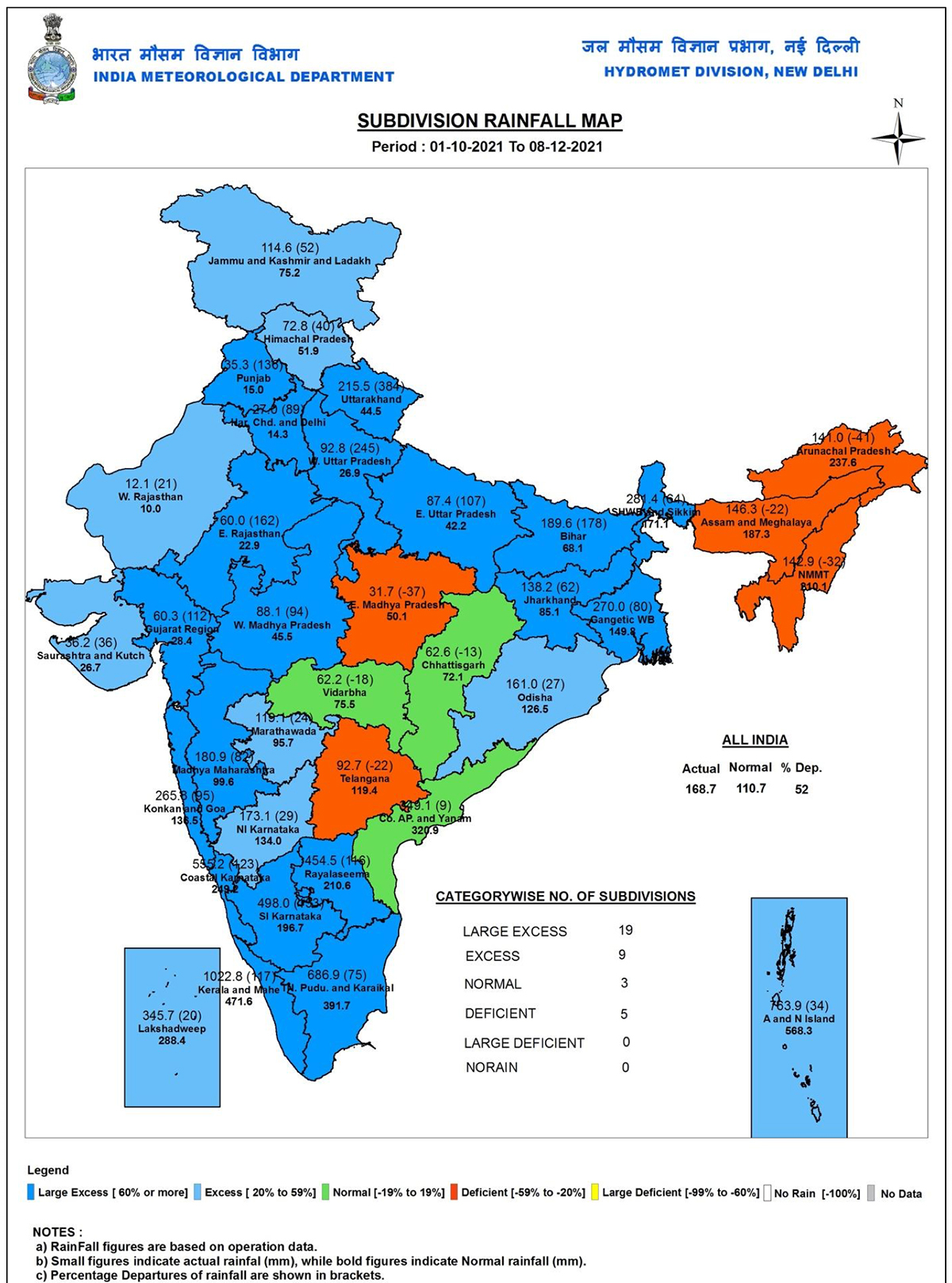


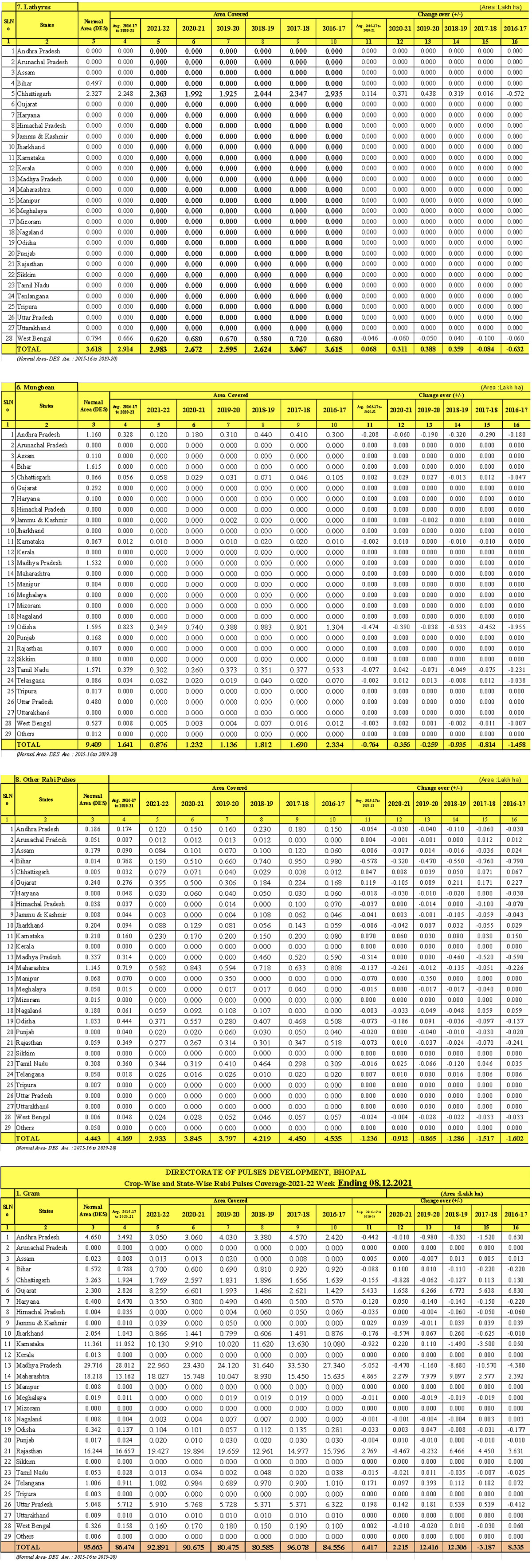
Abbreviations
Tuar/ Arhar: Pigeon Peas PP
Mung : Green Mung
Urad: Black Matpe
Chana: Gram, Desi Chickpea
Matar: Pea
Masur: Lentil
Besan: Gram Flour
Mandi: Market yard
Bhav: Prices
Dal/Daal: Processed Pulses (Directly for human consumption)
Rs: Indian Rupees (1$=Rs 75.77) 13 Dec. 21 at 09:28 PM IST
Rahul Chauhan
Director, IGrain India
igrainind@gmail.com
+91 9350141815
Twitter igrain_india

IGrain / Rahul Chauhan / India / Tuar / Pigeon Pea / Burma / Delhi / Maharashtra / Karnataka / New Delhi / Jaipur / Chick Peas / Desi Chick Peas / Black Matpe / Mung / Red Kidney / Cowpea / Lentil / Pigeon Pea
Disclaimer: The opinions or views expressed in this publication are those of the authors or quoted persons. They do not purport to reflect the opinions or views of the Global Pulse Confederation or its members.